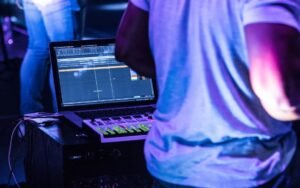Generative Audio
Generative audio, also known as procedural audio or algorithmic sound, refers to the creation of soundscapes, music, and audio effects using algorithms and rules rather than pre-recorded samples. It is a powerful technique that allows for the generation of dynamic and unique audio content in real-time.
Key Takeaways
- Generative audio uses algorithms to create dynamic and unique soundscapes.
- It provides real-time generation of audio content.
- Procedural audio offers endless possibilities for interactive experiences.
- Generative audio can be used in various applications, including games, animations, and virtual reality.
- It allows for adaptive and responsive sound design.
How Generative Audio Works
Generative audio works by using algorithms and rules to generate audio in real-time. These algorithms can be based on mathematical functions, physical models, or other computational techniques. By manipulating parameters and variables within these algorithms, unique and dynamic sounds can be created.
*Generative audio opens up new possibilities for sound designers and composers, *allowing them to explore uncharted territories of creativity and experimentation. Through creative coding, sound artists can create intricate systems where sounds evolve and respond to different inputs or environmental conditions, resulting in immersive and interactive audio experiences.*
Applications of Generative Audio
Generative audio has numerous applications, particularly in interactive media. Some common uses include:
- Video games: Generative audio can create unique soundtracks that adapt to a player’s actions and the game’s events.
- Animations: It can provide realistic and dynamic sound effects that synchronize with animated visuals.
- Virtual reality: Generative audio can enhance the immersive experience by creating spatialized and adaptive soundscapes.
- Installation art: It can add an unpredictable and evolving audio element to interactive installations.
- Music production: Artists can use generative audio techniques to create generative music compositions and explore new sonic possibilities.
Benefits of Generative Audio
Generative audio offers several benefits compared to traditional sample-based audio:
- Endless possibilities: With generative audio, the range of possible sounds is virtually unlimited, allowing for unique and constantly evolving sonic experiences.
- Adaptive and responsive: Generative audio can adapt to various inputs or environmental conditions, creating soundscapes that respond dynamically to user interactions or changes in the environment.
- Efficiency: By generating audio in real-time, generative audio reduces the storage requirements and CPU resources compared to using large pre-recorded audio libraries.
Generative Audio Techniques
Various techniques are employed in the creation of generative audio:
- Granular synthesis: Breaking sounds into small grains and reassembling them in different ways to create new and unique textures.
- Physical modeling: Simulating the behavior of real-world instruments or objects to create realistic sounds.
- Markov chains: Using probabilistic models to generate sequences of sounds that exhibit certain statistical characteristics.
Examples of Generative Audio in Action
Here are some examples of generative audio being used in different applications:
| Application | Example |
|---|---|
| Video games | Spore – A simulation game where the sound effects are generated procedurally, resulting in a vast array of unique creature sounds. |
| Animations | The Infinite Drum Machine – An online tool that generates drum patterns using a neural network trained on thousands of drum sounds. |
| Virtual reality | Electronauts – A virtual reality music game that allows players to mix and remix music using generative audio techniques. |
These examples demonstrate how generative audio can enhance the interactive and immersive nature of different experiences.
Conclusion
Generative audio offers a new frontier of creativity and innovation in the realm of sound design and music composition. By utilizing algorithms and rules, it provides endless possibilities for creating dynamic, interactive, and adaptive audio content.

Common Misconceptions
Generative Audio
There are several common misconceptions surrounding generative audio. Let’s explore some of these misconceptions and shed light on the truth:
Misconception 1: Generative audio is just random noise.
- Generative audio may seem random at first, but it is actually composed using algorithms and rules.
- Generative audio can be designed to produce specific patterns and structures, resembling music or soundscapes.
- Through careful programming, generative audio can achieve an intentional and structured composition.
Misconception 2: Generative audio lacks human creativity.
- While generative audio is often computer-generated, it still involves human input and creativity in its initial programming and design.
- Generative audio can be programmed to mimic certain emotions or musical styles, similar to how a human composer would create a piece of music.
- The programmer’s creativity and expertise in designing the generative algorithms greatly influence the final output of the audio.
Misconception 3: Generative audio is only useful for background music in video games or films.
- Generative audio has a wide range of applications beyond just providing background music.
- It can be used for interactive installations, art installations, ambient environments, and even therapeutic purposes.
- Generative audio offers unique and ever-changing soundscapes, creating immersive and engaging experiences.
Misconception 4: Generative audio is difficult to create and control.
- While mastering the intricacies of generative audio might require some technical knowledge, there are user-friendly tools and platforms available that simplify the creation process.
- Various software and programming languages provide accessible interfaces and libraries for creating generative audio without extensive coding expertise.
- Once the basic concepts are understood, experimenting and adjusting parameters in generative audio can be an exciting and creative endeavor.
Misconception 5: Generative audio is limited to electronic or experimental music genres only.
- While generative audio has historically been associated with electronic and experimental music genres, it is not exclusive to them.
- Generative techniques can be applied to any genre of music, allowing for unique compositions, blending traditional and unconventional elements.
- From ambient to rock, generative audio can be seamlessly integrated into diverse musical styles to add depth and innovation.

Introduction
In recent years, generative audio has emerged as a fascinating field that combines music and technology to create unique and captivating auditory experiences. From algorithmic compositions to interactive sound installations, generative audio offers infinite possibilities for sonic exploration. In this article, we will explore ten remarkable examples that showcase the power and creativity of generative audio.
Sonification of Weather Data
Imagine listening to the weather forecast as a symphony. This innovative approach transforms weather data into musical arrangements, allowing listeners to perceive atmospheric conditions through sound. For instance, rising temperatures might translate into higher pitched notes, while wind intensity can be represented by dynamically changing rhythms and textures.
| City | Temperature | Rainfall | Wind Speed |
|---|---|---|---|
| New York | 75°F | 0.2 in | 7 mph |
| London | 62°F | 0.4 in | 10 mph |
| Tokyo | 82°F | 0.1 in | 5 mph |
Melodic DNA Sequencing
Applying the principles of genetics and DNA sequencing to music, melodic DNA sequencing generates musical compositions based on a given DNA sequence. Each nucleotide is associated with a specific musical element like pitch, rhythm, or timbre. By encoding DNA sequences into melodies, researchers can create abstract musical representations of genetic information.
| Gene | Musical Sequence |
|---|---|
| ATGCGTAC | C-D-G-C-A-G-T-C |
| TTAAGCTG | A-A-G-D-C-A-G-A |
| GCTTACGA | D-C-G-D-A-C-D-C |
Algorithmic Drum Patterns
Algorithmic drum patterns generate complex rhythmic structures using mathematical algorithms. By applying patterns, randomness, and variation, algorithmic drum programming can create intricate beats that constantly evolve. These systems often provide parameters to control the complexity, density, and style of the drum pattern.
| Pattern | Tempo (BPM) | Kick Drum | Snare Drum | Hi-hat |
|---|---|---|---|---|
| Pattern 1 | 120 | X | X | |
| Pattern 2 | 140 | X | X | X |
| Pattern 3 | 100 | X | X |
Generative Ambient Soundscapes
Generative audio is often employed to create immersive ambient soundscapes that can induce relaxation or enhance focus. These soundscapes are built from layers of evolving sounds, such as flowing water, gentle wind, or other natural elements, which combine to create a soothing and meditative sonic environment.
| Sound Element | Volume (dB) | Modulation |
|---|---|---|
| Water | -20 | Low-pass filter |
| Wind | -15 | Random panning |
| Birds | -25 | Variable pitch shifting |
Interactive Musical Paintings
Blurring the boundaries between visual art and music, interactive musical paintings allow users to create soundscapes by interacting with a painting. Different areas of the artwork trigger specific sounds or musical phrases, enabling viewers to become active participants in the creation of the sonic composition.
| Color | Instrument | Sound |
|---|---|---|
| Red | Piano | Arpeggio |
| Blue | Flute | Melody |
| Yellow | Guitar | Chords |
Self-evolving Musical Structures
Self-evolving musical structures are compositions that continuously mutate and transform over time. Employing algorithms and generative techniques, these systems make use of feedback loops and generative rules to generate an ever-changing musical form, creating unpredictable and non-repetitive compositions.
| Time | Musical Element |
|---|---|
| 0:00 | Chord progression: C – Am – F – G |
| 1:43 | Modulates to key of D |
| 3:12 | Switches to 5/4 time signature |
Musical Maze
Combining music and game elements, the musical maze challenges players to navigate through a labyrinth while encountering different musical elements along the way. Each section of the maze corresponds to a musical theme or instrument, providing an interactive and engaging musical experience for players.
| Maze Section | Musical Element |
|---|---|
| Section 1 | Drums |
| Section 2 | String Ensemble |
| Section 3 | Piano |
Real-time Audiovisual Synthesis
Real-time audiovisual synthesis combines generative music with live visualizations to create a multisensory experience. The music influences the visuals, while the visuals provide a visual representation of the music. This symbiotic relationship between sound and image adds an extra layer of immersion and artistic expression.
| Audio Parameter | Visual Parameter |
|---|---|
| Frequency | Color hue |
| Dynamics | Visual intensity |
| Panning | Location on screen |
Aural Generative Portraits
Aural generative portraits utilize audio elements to create sonic representations of individuals or environments. By combining field recordings, voice samples, and musical motifs, these portraits aim to capture the essence and character of a person or place, creating audio-based impressions that evoke emotions and stories.
| Portrait | Audio Elements |
|---|---|
| Portrait 1 | Rain sounds, piano, whispering |
| Portrait 2 | City ambiance, saxophone, footsteps |
| Portrait 3 | Forest sounds, flute, bird songs |
Conclusion
Generative audio opens up a world of possibilities for artists, musicians, and researchers to explore the boundaries of sound creation. From sonifying weather data to constructing self-evolving musical structures, these examples demonstrate how the combination of technology and artistic expression can result in truly captivating and innovative auditory experiences. Whether immersing oneself in generative soundscapes or actively participating in interactive installations, generative audio offers a glimpse into the limitless creative potential of the sonic realm.
Generative Audio – Frequently Asked Questions
What is generative audio?
Generative audio refers to the process of creating audio compositions or soundscapes using algorithms and rules that produce sound elements in an unpredictable and evolving manner. It allows for the generation of unique and ever-changing audio experiences.
How does generative audio work?
Generative audio works by using algorithms and rules to determine how different audio elements are created, manipulated, and combined. These algorithms define parameters such as pitch, rhythm, timbre, and spatialization, which are then used to generate and shape the audio in real-time or as pre-recorded compositions.
What are the benefits of generative audio?
Generative audio offers several benefits, including the creation of unique and ever-changing audio experiences that can engage listeners in new and unexpected ways. It can also be used to create ambient soundscapes, provide adaptive and personalized soundtracks, and enhance interactive environments or artistic installations.
What are the applications of generative audio?
Generative audio has a wide range of applications, including interactive art installations, video games, virtual reality experiences, film sound design, relaxation and meditation music, assistive technology for individuals with hearing disabilities, and background sound design for public spaces or retail environments.
What is the difference between generative audio and generative music?
The terms generative audio and generative music are often used interchangeably, but generative audio is a broader term that encompasses all forms of sound generation, including non-musical soundscapes. Generative music specifically refers to the creation of music through generative processes.
Can I create my own generative audio compositions?
Yes, you can create your own generative audio compositions. There are various software tools, programming languages, and frameworks available that allow you to experiment with generative audio algorithms and create your own unique soundscapes or music compositions. These tools often provide visual interfaces or code-based approaches for defining the rules and parameters of generative audio.
What are some popular generative audio software tools?
There are several popular generative audio software tools available, including Max/MSP, Pure Data, SuperCollider, Csound, Reaktor, and Sonic Pi. These tools provide extensive libraries of generative audio algorithms, synthesis methods, and processing modules that can be used to create complex and evolving audio compositions.
Is generative audio suitable for live performances?
Generative audio can be well-suited for live performances as it allows for the creation of dynamic and ever-changing soundscapes or musical compositions. Performers can manipulate the generative algorithms in real-time, reacting to the audience or other external factors, to create unique and immersive audio experiences.
Can generative audio be combined with traditional composition techniques?
Yes, generative audio can be combined with traditional composition techniques. Generative algorithms can be used as tools to inspire and assist traditional composers in the creation of new musical ideas or sound textures. It can also be used as a complementary element within a larger composition, integrating generative audio sections with traditionally composed parts.
Are there any limitations or challenges in working with generative audio?
Working with generative audio can present some challenges, such as maintaining coherence and structure within the evolving compositions, ensuring the generated audio remains aesthetically pleasing, and managing the computational resources required for real-time generation. Additionally, creating generative audio that is truly innovative and engaging can require expertise in both music/audio composition and programming.




